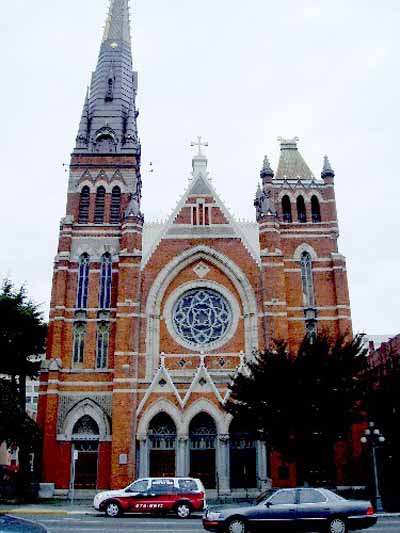St. Andrew's Roman Catholic Cathedral National Historic Site of Canada
Victoria, British Columbia

General view
(© Parks Canada Agency / Agence Parcs Canada, Mario Savard, 2008.)
Address :
Blanshard Street, Victoria, British Columbia
Recognition Statute:
Historic Sites and Monuments Act (R.S.C., 1985, c. H-4)
Designation Date:
1990-02-23
Dates:
-
1890 to 1892
(Construction)
Event, Person, Organization:
-
Perrault and Mesnard
(Architect)
-
J.H. Donovan
(Builder)
Other Name(s):
-
St. Andrew's Roman Catholic Cathedral
(Designation Name)
Research Report Number:
GOTHIC REVIVAL-1989
Plaque(s)
Existing plaque: Blanshard Street, Victoria, British Columbia
Soaring skywards with its bold array of coloured brick, stone and slate, St. Andrew's Roman Catholic Cathedral displays the confident spirituality that characterizes the best religious architecture of the High Victorian Gothic style. Designed in 1892 by Perrault and Mesnard of Montréal, St. Andrew's was inspired by the medieval cathédrale of Europe, whose emphatic verticality and picturesque asymmetry greatly appealed to 19th-century Roman Catholic taste. The wall patterns, created by combining building materials of different colours, are a distinctive feature of the mature phase of the Gothic Revival style.
Description of Historic Place
St. Andrew’s Roman Catholic Cathedral National Historic Site of Canada is an imposing heritage landmark in the urban core of Victoria, B.C. The cathedral’s twin-towered design has a strong vertical emphasis and a picturesque asymmetry that is enhanced by a soaring spire and a bold combination of red brick, pale grey stone, slate and metal building materials. Ornate vaulting, stained glass and galleries contribute to the sense of grandeur within the well-preserved interior. The designation refers to the cathedral on its legal lot at the time of designation in 1990.
Heritage Value
St. Andrew’s Roman Catholic Cathedral was designated a national historic site of Canada in 1990 because: it is a fine representative example of the Gothic Revival Style.
Designed in 1892 by Perrault and Mesnard of Montreal, and built by contractor J.H. Donovan, St. Andrew’s was inspired by the medieval cathedrals of Europe, whose emphatic verticality and picturesque asymmetry greatly appealed to 19th-century architectural taste. The influence of French Gothic Revival style is evident in the twin towered façade, centre rose window and the triple entrance portal. Features such as the rich array of contrasting colours and materials created by the red-brick walls with grey stone trim and slate roof were characteristic of the High Victorian Gothic Revival Style.
Character-Defining Elements
Aspects of this site which contribute to its heritage value include: the complex cruciform plan, including the complementary but not identical front towers, single tall spire, narthex, nave, transepts, polygonal apse and two galleries above the narthex, reflecting the influence of French Gothic sources on the design; the use of French Gothic-inspired detailing including triplet entranceway, corner piers and wall buttresses, decorated parapets, the rose window located above the main entrance, polished granite columns and wall surrounds on the main entrance, rose windows on both transept end walls, and trefoil windows on the walls of the nave and apse; the High Victorian taste for rich and varied surface design evident in the use of polychrome in the slate roofing, detailing of red brick wall surfaces with limestone, the use of polished granite details, the diaper-work panels on the front façade, ornate metal eaves and roof ornamentation; interior features including the ornamental vaulting, stained and coloured glass windows, decorative plaster detailing, columns and galleries.